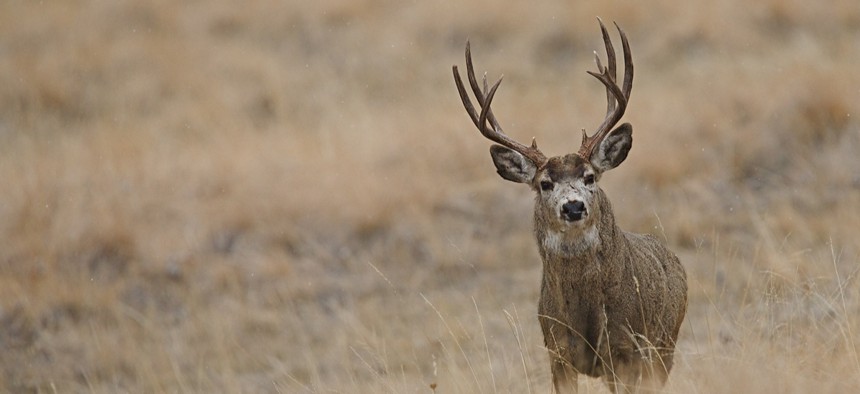Monitoring Deer Health Means a Helicopter Ride for a Utah Herd

The state uses helicopters to transport and monitor populations of several animals, including mule deer, bighorn sheep and antelopes. Shutterstock
About 50 mule deer in Utah were flown recently to a state-owned ranch to allow wildlife biologists to examine and tag them. Officials said the tests give them important insights into the health of the herd as a whole.
Christmas Eve is a month away, but deer have already taken to the skies in northern Utah.
About 50 mule deer were airlifted by helicopter last week from Antelope Island, a state park on the southeastern side of the Great Salt Lake, to a nearby ranch on the island, where state wildlife officials examined each animal for clues about the health of the herd as a whole.
“We take blood samples, we take metrics on the size of the animals as far as body lengths, and we also use an ultrasound to measure how much fat reserves they have,” said Eric Anderson, a wildlife biologist with the Utah Division of Wildlife Resources. “That’s important, because for animals here in the west, winter survival depends on how much fat they have.”
The results of those tests give the state important insights to the status of its mule deer population, Anderson said. The fat stores on individual animals, for example, tell researchers whether the deer on Antelope Island are getting enough to eat or if the herd has become too large for the available resources. At the moment, the herd appears to be at a healthy size.
The state contracts with a South Africa-based private capture company to transport the animals, a process that begins by canvassing the area by helicopter. When the team spots a mule deer, they shoot a net from a gun in the air to trap it, then land the helicopter and dispatch a team member to remove the net, blindfold the animal and restrain it in a bright orange bag. The deer are then airlifted to the waiting biologists, typically in dangling chains of two or three at a time.

The state uses the same method to track its other animal populations, including antelope and bighorn sheep. It’s faster than sending biologists out on foot, Anderson said, and safer for both the animals and the scientists.
“We’d have to use tranquilizers, and that can be very hard on the deer, believe it or not—harder than what we’re doing,” he said. “The drugs we use on deer are sometimes lethal to humans, so that’s another risk. And if I tried to go out here on the ground I’d have to get to within 30 yards of a deer. I could spend all day trying to get one, and with a helicopter, we can get 30.”
The deer are monitored throughout the process to minimize stress. If an animal is particularly aggressive or its heart rate or temperature spike above acceptable levels, a state veterinarian will administer a mild sedative, usually at a very low dose.
“All in all, the biggest concern that comes in when we’re capturing animals is the safety of the animal and maintaining low stress levels,” he said, “along with the safety of the employees doing the captures.”

Examining each deer takes about 10 minutes. When the assessments are completed, many of the mule deer are outfitted with GPS collars, which allow researchers to keep tabs on their movement and also locate them quickly when they die. That gives scientists the opportunity to monitor causes of death within the herd, including hunting, car accidents and natural causes. It also lets Anderson know that the deer are capable of finding their way back home from the ranch—usually in very little time.
“They run away pretty quickly and they find their way back pretty quickly,” he said. “It’s actually pretty amazing how fast they can get back to an area, but I guess when you have four legs, it’s not that hard to climb a mountain.”
Kate Elizabeth Queram is a Staff Correspondent for Route Fifty and is based in Washington, D.C.
NEXT STORY: After Floods, Some Cities Take On More Restrictive Zoning and Building Regulations





